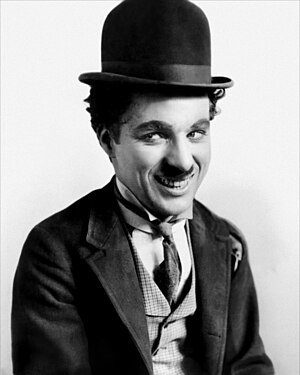 Image via Wikipedia
Image via WikipediaNamed after his father, a British music hall entertainer, Chaplin spent his early childhood with his mother, the singer Hannah Hall. He made his own stage debut at age five, filling in when his mother lost her voice in mid-song. The mentally unstable Hall was later confined to an asylum, whereupon Charlie and his half-brother Sydney were sent to a series of bleak workhouses and residential schools. Using his mother's show-business contacts, Charlie became a professional entertainer in 1897 when he joined the Eight Lancashire Lads, a clog-dancing act. His subsequent stage credits included a small role in William Gillette's Sherlock Holmes and a stint with the vaudeville act Casey's Court Circus. In 1908 he joined the Fred Karno pantomime troupe, quickly rising to star status as The Drunk in the ensemble sketch A Night in an English Music Hall.
While touring America with the Karno company in 1913, Chaplin was signed to appear in Mack Sennett's Keystone comedy films. Though his first Keystone one-reeler, Making a Living (1914), was not the failure that historians have claimed, Chaplin's initial screen character, a mercenary dandy, did not show him to best advantage. Ordered by Sennett to come up with a more workable screen image, Chaplin improvised an outfit consisting of a too-small coat, too-large pants, floppy shoes, and a battered derby. As a finishing touch, he pasted on a postage-stamp mustache and adopted a cane as an all-purpose prop. It was in his second Keystone film, Kid Auto Races at Venice (1914), that Chaplin's immortal screen alter ego, “the Little Tramp,” was born.
In truth, Chaplin did not always portray a tramp; in many of his films his character was employed as a waiter, store clerk, stagehand, fireman, and the like. His character might be better described as the quintessential misfit: shunned by polite society, unlucky in love, jack-of-all-trades but master of none. He was also a survivor, forever leaving past sorrows behind, jauntily shuffling off to new adventures. The Tramp's appeal was universal: audiences loved his cheekiness, his deflation of pomposity, his casual savagery, his unexpected gallantry, and his resilience in the face of adversity. Some historians have traced the Tramp's origins to Chaplin's Dickensian childhood, while others have suggested that the character had its roots in the motto of Chaplin's mentor, Fred Karno: “Keep it wistful, gentlemen, keep it wistful.” Whatever the case, within months after his movie debut, Chaplin was the screen's biggest star.
His 35 Keystone comedies can be regarded as the Tramp's gestation period, during which a caricature became a character. The films improved steadily once Chaplin became his own director. In 1915 he left Sennett to accept a $1,250-weekly contract at Essanay Studios. It was there that he began to inject elements of pathos in his comedy, notably in such shorts as The Tramp (1915) and Burlesque on Carmen (1916). He moved on to an even more lucrative job ($670,000 per year) at the Mutual Company Film Corporation. There, during an 18-month period, he made the 12 two-reelers that many regard as his finest films, among them such gems as One A.M. (1916), The Rink (1916), The Vagabond (1916), and Easy Street (1917)....learn more
credit to: http://www.biography.com/
